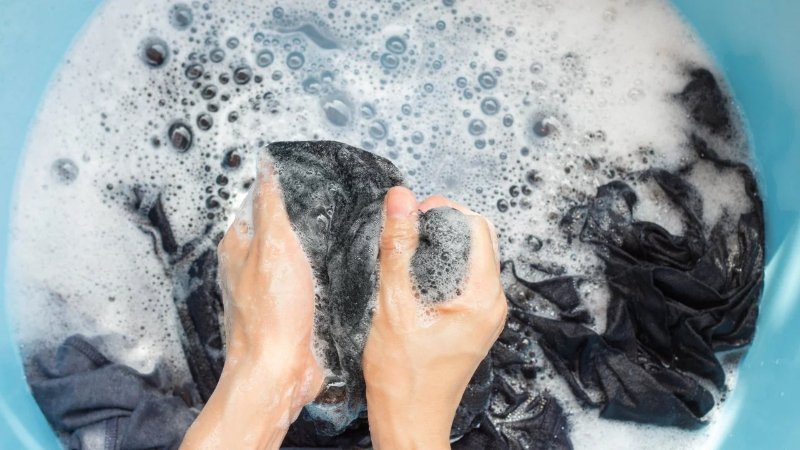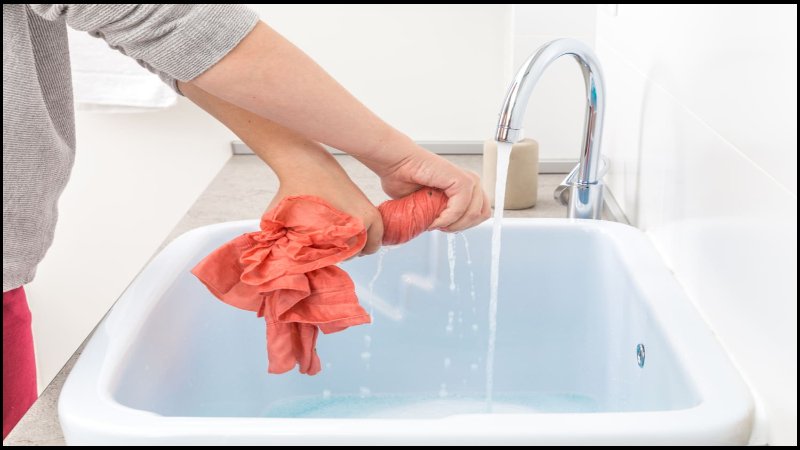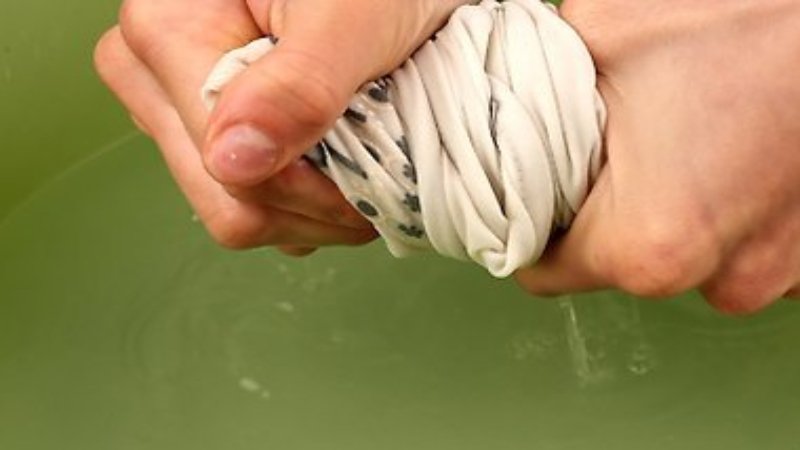Gentle Care, Lasting Wear: The Expert Guide to Hand Washing Clothes
Protect your delicate garments and extend their lifespan with the art of hand washing. This comprehensive guide empowers you to gently and effectively clean even the most precious fabrics. Learn to avoid common mistakes, preserve clothing quality, and embrace a more sustainable laundry approach, saving money. Let’s read!
1. Benefits of Hand Washing Clothes
This section highlights the numerous advantages of hand washing, particularly for delicate garments. We’ll explore how it preserves fabric integrity, extends garment lifespan and contributes to a more sustainable and cost-effective laundry routine.

1.1 Gentler on Delicate Fabrics
Hand washing provides a significantly gentler approach compared to the harshness of washing machines. The controlled agitation and lack of tumbling minimize stress on delicate fabrics like silk, wool and lace. This prevents damage that can occur in machines.
1.2 Preserves Garment Quality and Longevity
By reducing wear and tear, hand washing extends the lifespan of your clothes, especially delicate and “hand wash only” items. It helps prevent fading, stretching, shrinking and damage to embellishments or intricate details.
1.3 Cost-Effective and Energy-Saving
Hand washing saves money on utility bills by reducing your reliance on washing machines and dryers. It significantly lowers water and energy consumption, contributing to a more sustainable lifestyle and reducing your environmental footprint. Cost-effective and eco-friendly.
2. Preparing Your Clothes for Hand Washing
2.1 Understanding Care Labels
Care labels are your primary guide for proper garment care. Always check the care label before washing any item. These labels provide crucial information about recommended washing methods, water temperature and drying instructions.
Care labels may use symbols or written instructions. If you’re unfamiliar with the symbols, numerous online resources can help you decipher them. Countless garments ruined by ignoring care labels, I can’t stress enough how important this step is.
2.2 Sorting Clothes for Hand Washing
Proper sorting is essential to prevent damage and ensure effective cleaning. Sort clothes by color: Separate lights, darks and whites to prevent dye transfer, especially with new or brightly colored items.
- Separate clothes by fabric type: Group similar fabrics together (e.g., cottons, silks, wools, synthetics) as they often require different water temperatures and handling.
- Consider the level of dirtiness: Heavily soiled items may need pre-soaking or separate washing.
2.3 Materials Needed for Hand Washing
Gathering the right materials before you begin is essential for a smooth and effective hand-washing process. This section lists the necessary items, ensuring you have everything you need for gentle and thorough cleaning.
- Large Sink or Wash Basin: A clean, non-reactive basin (plastic, ceramic or stainless steel) is ideal. Ensure it’s large enough to comfortably submerge the garments.
- Lukewarm or Cool Water: Avoid hot water, which can damage delicate fabrics and cause shrinkage or color fading. Lukewarm or cool water is generally best.
- Gentle Detergent: Choose a detergent specifically formulated for hand washing or delicates. These detergents are milder and less likely to damage sensitive fibers.
- Laundry Detergent Sheets: (Optional) consider using, especially convenient for travel.
- Soft Towels: Microfiber or cotton towels are excellent for absorbing excess water after rinsing.
- Drying Rack (Optional): A drying rack is ideal for laying garments flat to air dry, preventing stretching or distortion.
- Padded Hangers (Optional): Padded hangers are useful for hanging certain items to air dry, preventing shoulder creases.
3. Creating the Ideal Detergent Solution
3.1 Mixing Detergent and Water
Start with lukewarm water as the base for your washing solution. This temperature is generally safe for most delicate fabrics. Always dissolve the gentle detergent in the water before adding your clothes.
Add the detergent to the water and stir thoroughly to ensure it’s fully dissolved and evenly distributed. This prevents concentrated detergent from directly contacting and potentially damaging the fabric.

3.2 Dosage Matters: Avoiding Over-Soaping
For hand washing a small load of delicates, use approximately one teaspoon of gentle liquid detergent. Using the correct amount of detergent is crucial. Oversoaping leads to residue buildup, making fabrics stiff and attracting dirt.
Residue can also dull colors and irritate sensitive skin. Less is often more, especially with concentrated detergents. Always follow the detergent manufacturer’s instructions but err on the side of using slightly less.
3.3 When You Don’t Have Detergent: Emergency Substitutes
In an emergency, if you don’t have laundry detergent, you can temporarily use a small amount of dishwashing liquid or a mild bar soap. However, this is a backup plan, not a primary recommendation. While dish soap or bar soap can work in a pinch, they aren’t ideal long-term.
Dish soap and bar soap can be harsher than laundry detergents and may leave behind residue. If using these substitutes, use them very sparingly and rinse the garments extremely thoroughly.
4. Step-by-Step Guide to Hand Washing Clothes
4.1 Submerging and Soaking
Fill your wash basin with lukewarm water and the prepared detergent solution. Add your garments, washing only one or two items at a time to avoid overcrowding and ensure even cleaning. Gently swish the water to distribute the soap evenly around the clothes.
Allow the garments to soak for 15-30 minutes. For heavily soiled items, you can soak for up to an hour. For very delicate fabrics like silk, shorten the soaking time to 10-15 minutes. Avoid scrubbing or twisting the fabric during soaking as this can cause damage.
4.2 Treating Stains Before Washing
Pre-treating visible stains before hand washing significantly improves the chances of removal. Apply a small amount of gentle detergent or an enzyme-based stain remover directly to the stain.
Gently work the solution into the fabric with your fingertips. Avoid aggressive scrubbing, which can damage the fibers. Let the stain treatment sit for about 10 minutes before proceeding with hand washing. The type of stain may influence the best treatment.

4.3 Rinsing Clothes Thoroughly
Thorough rinsing is crucial to remove all traces of detergent. Drain the soapy water from the basin. Refill the basin with cool, clean water. Immerse the garments and gently push them up and down in the water to release the soap.
Repeat the rinsing process several times, changing the water each time, until the water runs completely clear and no soap residue remains. For very delicate items, you can add a tiny amount of fabric softener to the final rinse (optional) but ensure it’s thoroughly rinsed out afterward.
5. Drying Hand-Washed Clothes Properly
5.1 Squeezing Out Excess Water Gently
After rinsing, gently squeeze out excess water from the garments. Avoid wringing or twisting, especially for delicate fabrics as this can cause stretching, wrinkling and damage to the fibers.
Lay the garment flat on a clean, dry towel. Roll the garment up in the towel like a jelly roll. Gently press on the rolled-up towel to absorb more moisture. This helps remove excess water without stressing the fabric.
5.2 Using Towels and Drying Racks for Air Drying
The best way to dry hand-washed clothes is to air dry them. Lay garments flat on a clean drying rack or a clean, dry towel. This helps maintain their shape and prevents stretching.
For delicate knitwear, rolling in a towel to remove excess water is crucial before laying flat to dry. This prevents the weight of the water from stretching the garment out of shape.
5.3 Air-Drying Heavier Items and Ensuring Even Drying
For heavier items or those that might lose their shape, laying flat to dry is essential. Reshape knitted items before drying, smoothing them out to their original form. Place the garment on a flat surface in a well-ventilated room.
Avoid placing garments in direct sunlight or near a direct heat source as this can cause fading or damage. Flip the garment over a couple of times during the drying process to speed up drying and ensure even drying. In humid environments, turn garments periodically to prevent mildew.

6. Special Care for Different Fabrics
6.1 Cotton and Linen
- Cotton: Wash cotton garments in lukewarm water.
- Linen: Wash linen garments in cool water to preserve their texture and color.
- Drying Tip: Both cotton and linen can be air-dried or tumble-dried on low heat but air drying is gentler and reduces wrinkling.
6.2 Silk and Wool
- Silk: Wash silk garments in cool water with a gentle detergent specifically designed for silk.
- Wool: Never expose wool items to heat as this can cause shrinkage. Use cool water and a gentle detergent.
- Drying Tip: Gently press out excess water from both silk and wool. Lay flat to dry on a clean, dry towel. Never twist or wring these fabrics. Avoid direct sunlight, which can fade colors and damage fibers. Dry in a shaded, well-ventilated area.
6.3 Synthetic Fabrics (Polyester)
- Polyester: Polyester is generally resilient, durable, and dries quickly. Hand wash in lukewarm or cool water.
- Drying Tip: Air dry or tumble dry on low heat. Polyester is less prone to shrinking or stretching than natural fibers.
6.4 Lace and Lingerie
- Lace and Lingerie: Always hand wash lace and lingerie due to their delicate nature.
- Drying Tip: Use a very gentle detergent. Lay flat to dry to maintain shape and elasticity. Avoid hanging, which can cause stretching.
6.5 Swimwear
- Swimwear: hand wash immediately after use to remove chlorine or salt water.
- Use cool water with mild detergent
- Drying Tip: Air dry flat to preserve elasticity.
7. Hand Washing Don’ts: Common Mistakes to Avoid
Avoiding common mistakes is just as important as following the correct steps. This section highlights crucial “don’ts” to prevent damage and ensure successful hand washing. Preventing errors is key to garment longevity.
Here are some crucial mistakes to avoid:
- Ignoring Care Instructions: Always follow the care instructions on the garment label. These instructions are specific to the fabric and construction.
- Aggressive Scrubbing or Wringing: Avoid scrubbing or wringing the fabric aggressively. This can damage fibers, stretch the garment and cause wrinkling.
- Oversoaking: Do not oversoak clothes, especially delicate fabrics. Prolonged soaking can weaken fibers and cause color fading.
- Ignoring Color Sorting: Sort clothes by color and fabric type before hand washing. Never hand wash dark and light colors together, as this can lead to dye transfer.
- Overcrowding: Don’t overcrowd the sink or tub. Wash in small batches to ensure each garment is cleaned and rinsed thoroughly.
- Using a Hot Dryer: Never place delicate, hand-washed items in a hot clothes dryer. High heat can cause shrinkage, warping, and other damage.
- Using Hot Water Unnecessarily: Lukewarm or cool water is generally safer for hand washing. Hot water can shrink some fabrics, set stains and fade colors.
8. Environmental Impact of Hand Washing
Beyond preserving your clothes, hand washing offers significant environmental benefits. This section highlights how this simple practice contributes to a more sustainable lifestyle by reducing water and energy consumption. Eco-conscious laundry is a positive step.
Here’s a breakdown of the environmental benefits:
- Reduced Water Consumption: Hand washing significantly reduces water consumption compared to machine washing, especially for small loads. You only use the amount of water needed, minimizing waste.
- Energy-Free Laundry: Hand washing is an energy-free laundry method, requiring no electricity. This contrasts sharply with the energy demands of washing machines and dryers.
- Less Plastic Waste (with Detergent Sheets): Using laundry detergent sheets, instead of liquid detergent in plastic bottles, significantly reduces plastic waste. This contributes to a more sustainable laundry routine.
- Lower Carbon Footprint: By using less water and energy, hand washing reduces your overall carbon footprint. This makes it a more environmentally responsible choice compared to frequent machine washing.
9. FAQs about Hand Washing Clothes
9.1 Is hand washing clothes really necessary?
Yes, hand washing is necessary for several reasons:
- Delicates: It’s the gentlest method for delicate fabrics like silk, wool, lace and lingerie.
- Extending Garment Life: It reduces wear and tear, preserving the quality and extending the lifespan of your clothes.
- “Hand Wash Only” Labels: It’s essential for items specifically labeled “hand wash only.”
9.2 Can I use regular laundry detergent for hand washing?
Yes, you can use regular liquid laundry detergent, but dilute it more than you would for machine washing. A small amount goes a long way. Gentle detergents specifically formulated for hand washing or delicates are preferable as they are less harsh on fabrics.
9.3 How often should I hand wash clothes?
Hand wash clothes as needed, especially:
- Items worn close to the skin: Underwear, lingerie and some activewear benefit from more frequent washing.
- Delicate garments: Silk blouses, wool sweaters and lace items should be hand washed regularly to maintain their quality.
- “Hand Wash Only” items: Always follow the care label instructions.
- Items you want to preserve: Special or treasured garments.
9.4 How do I know if a garment is truly ‘hand wash only’?
The care label is your definitive guide. Look for the “hand wash” symbol (a tub with a hand in it) or the words “hand wash only.” If you’re unsure or if the label is missing, err on the side of caution and hand wash, especially for delicate or vintage items.
9.5 Can I hand wash clothes while traveling?
Yes, hand washing is ideal for travel. It allows you to pack lighter and keep your clothes clean without relying on laundry facilities. Laundry detergent sheets are particularly convenient for travel as they are lightweight, compact and mess-free. Use a sink, bathtub or a portable wash basin in your accommodation.
10. Packlove – Providing service for Garment Labels and Tags
Packlove recognize that proper garment care, including hand washing when appropriate, is essential for maintaining the quality and longevity of clothing. This care is reflected in the quality. We understand the importance of garment care, starting from clear and durable labels that guide consumers.
For brands offering delicate items best suited for hand washing, providing accurate care instructions through quality labels is key to customer satisfaction and garment longevity. We specialize in creating labels and tags.
We offer a wide range of label and tag options, including custom woven labels, printed labels, and hang tags. We can help you create clear, durable and informative care labels that guide your customers on proper washing techniques, including hand washing instructions.
Read more:
Hand washing clothes offers numerous benefits: it’s gentler on delicate fabrics, extends garment lifespan and is a more environmentally friendly laundry practice. By embracing hand washing for your delicate and special garments, you can preserve their quality, protect your investment, and contribute to a more sustainable lifestyle. Make hand washing a part of your garment care routine.






















